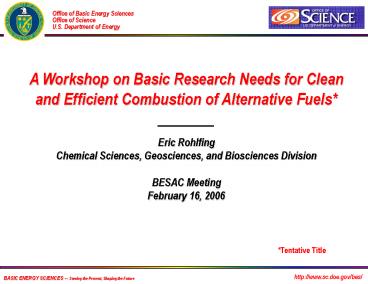BASIC ENERGY SCIENCES Serving the Present, Shaping the Future - PowerPoint PPT Presentation
1 / 6
Title:
BASIC ENERGY SCIENCES Serving the Present, Shaping the Future
Description:
Laser diagnostics applied to real diesel engines ... Multiple laser diagnostics (PLIF and LII) reveal evolution of diesel spray combustion ... – PowerPoint PPT presentation
Number of Views:76
Avg rating:3.0/5.0
Title: BASIC ENERGY SCIENCES Serving the Present, Shaping the Future
1
BASIC ENERGY SCIENCES -- Serving the Present,
Shaping the Future
Office of Basic Energy SciencesOffice of
ScienceU.S. Department of Energy
A Workshop on Basic Research Needs for Clean and
Efficient Combustion of Alternative Fuels Eric
Rohlfing Chemical Sciences, Geosciences, and
Biosciences Division BESAC Meeting February 16,
2006
Tentative Title
http//www.sc.doe.gov/bes/
2
Workshop motivation background
- Alternative Fuels
- Fuels other than those produced by refining
light, sweet crude oil. Alternative fuels
include those derived from renewable resources,
such as biodiesel or ethanol, and fuels obtained
via Fischer-Tropsch chemistry applied to heavy
crude, shale oil, tar sands, and coal. - The U.S. is likely to utilize these fuels in
internal combustion (IC) engines for
transportation after traditional fuels (gasoline,
diesel fuel) are exhausted and before hydrogen
can be utilized. - DOE and other agencies are supporting research
into enhancing the production of alternative
fuels from renewable resources (biomass). - But, we do not know the impact with regard to
efficiency and pollutant formation of the
widespread use of these fuels, particularly in
the next-generation of high-efficiency,
low-emission IC engines. - Conclusion A basic research program on the
clean and efficient combustion of alternative
fuels that assesses their potential impact on
modern IC engines is needed.
3
Tentative workshop details
- Basis
- The strong BES program in gas-phase chemistry,
combustion diagnostics, and combustion
simulation. - Organization
- Co-chairs from the Sandia Combustion Research
Facility (Andy McIlroy) and from academia in area
of combustion/engine research. - Breakout sessions TBD associated with
technology challenges with science crosscuts? - Participants (75) from national labs academia,
spanning range of fundamental chemistry and
applied combustion/engine research - Timing and location Fall 2006 (October) in DC
area - Coordination with EERE Office of Freedom Car and
Vehicle Technologies - Initial positive response from program manager
(Ed Wall) and chief scientist (Jim Eberhardt)
4
New Experimental Tools Reveal New Class of Flame
Intermediates
Advanced Light Source
- Enols are alchohols with an adjacent double bond
- Postulated in 1880 by Erlenmeyer
- Seen by NMR in 1973 and in gas phase in 1976
- Enols not currently in flame chemistry models
- Work by team of BES-funded researchers on the
Chemical Dynamics Beamline at the ALS (BL 9.0.2)
using molecular beam flame sampling with tunable
VUV photoionization reveals the presence of enols
in many flames - New chemistry needed to explain role of enols
- Shirley Award for most outstanding paper from ALS
in 2005
5
New simulation tools for turbulent combustion
- Direct Numerical Simulation of a 3D Turbulent
CO/H2/Air Jet Flame with Detailed Chemistry - Worlds largest DNS with detailed chemistry
generated 30 terabytes of data! - FY05 INCITE Award of 2.5 million CPU hours at
NERSC S3D code development via SciDAC scales
well on all platforms, including leadership class
machines at ORNL - Investigate fine-grained coupling between
turbulent mixing and finite-rate chemistry - Extinction and re-ignition dynamics
- Mixing time scales
- Preferential diffusion
- Physics at dissipation scales
- Benchmark dataset for validation of more
approximate models that might be applied to
engines, i.e., large-eddy simulations.
z
z
x
x
y
y
x
air
fuel
air
Molecular mixing in a planar jet flame
6
Laser diagnostics applied to real diesel engines
- Diagnostics developed under BES support enable
EERE sponsored engine research - Multiple laser diagnostics (PLIF and LII) reveal
evolution of diesel spray combustion































